/ Erfolgsgeschichten
Automatic preparation for cryo-EM analysis with no loss of material - Start-up cryoWrite delivers its first unit
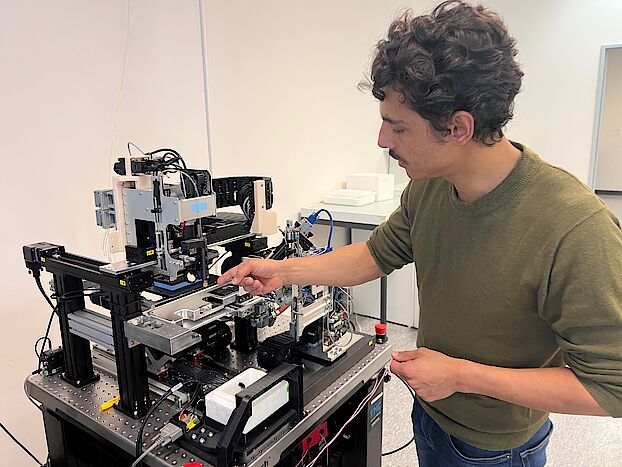
Nicolás Candia explains that the cryoWriter has over 100 sensors and 25 axes. With various expansion modules, the system serves as a mini laboratory in which samples can be cultivated, microscopically examined, prepared, applied to an EM grid, and vitrified.

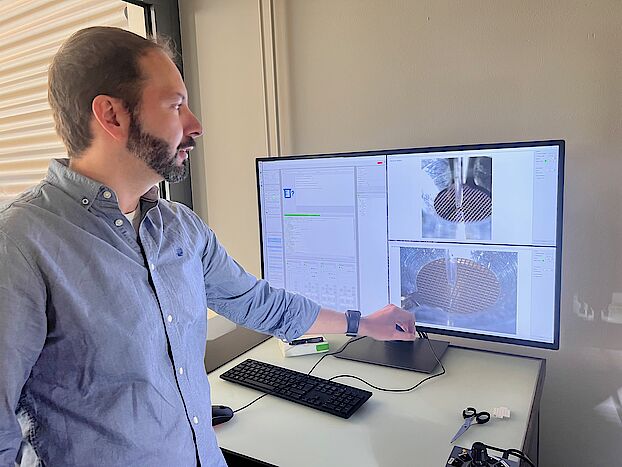
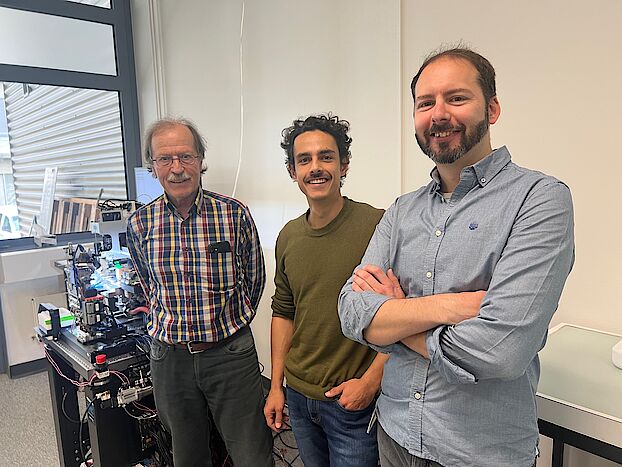
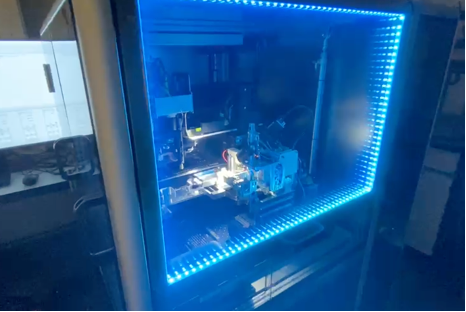
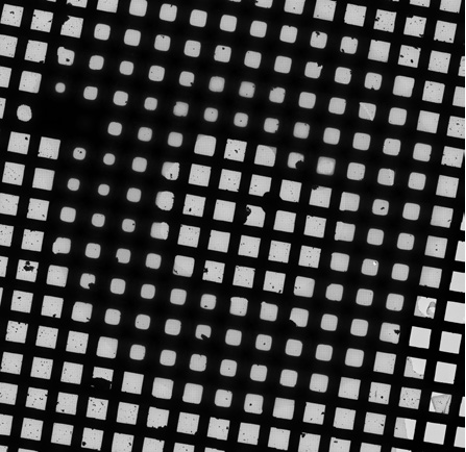
For several years, the name cryoWrite has cropped up within the SNI network in connection with an instrument used to prepare samples for cryo-electron microscopy. Moreover, a company has existed with this name since 2020 (and from October 2023 will be led by the SNI alumnus Dr. Patrick Frederix). The Basel-based start-up is launching an automated system that can be used to prepare tiny sample quantities for cryo-electron microscopy with no loss of material. The three members of staff at cryoWrite recently supplied their first instrument to Professor Henning Stahlberg’s group at EPFL and are currently working on another unit for the pharmaceutical company Roche. At the same time, the team is working to demonstrate the capabilities of its modular sample-preparation system to various customers.
Nowadays, it’s hard to imagine basic research without cryo-electron microscopy (cryo-EM), a technique that allows biological samples such as cells or proteins to be examined in their natural environment without having to be embedded, fixed or treated with a contrast agent. Thanks to continual technical improvements and optimized cameras, it is now possible to visualize and elucidate three-dimensional structures of molecules in individual cells using cryo-EM, which operates at temperatures below -180°C.
Glass-like water
One key part of this process is sample preparation. Here, it is vital to prevent the formation of ice crystals that destroy fine structures. Samples destined for cryo-EM are therefore shock-frozen at lightning speed to cause what experts call “vitrification” of the sample material. This converts the water to an amorphous, glass-like state to avoid damaging structures in the cell.
For years, Dr. Thomas Braun’s team at the Biozentrum of the University of Basel has been working to miniaturize and automate the sample-preparation process for cryo-EM. Several Nano-Argovia projects and doctoral dissertations have addressed different aspects of this process with support from the SNI — and their inventions have been patented with help from Unitectra in what represents a first step toward the development of a commercial device for cryo-EM sample preparation.
The founding of the start-up Nuonex in 2019 was the first attempt to commercialize this technology, but those efforts were ultimately shelved by the two young entrepreneurs.
Founded in summer 2020
In August 2020, however, the commercialization of the cryoWriter got underway in earnest when Professor emeritus Andreas Engel teamed up with two partners to found a company known as cryoWrite. The team was already familiar with the cryoWrite system as well as the benefits of an automated sample-preparation system for cryo-EM, and the researchers had an experienced investor on board in the shape of Dr. Hans-Andreas Engel from the board of the Biovalley Basel Association.
The aim of this fledgling company is to provide new avenues for efficient and reproducible sample preparation in the form of an automated, modular system for use with cryo-EM technology.
For example, the processing of biological samples begins with selecting a cell from a cell culture, breaking the cell up and extracting the cellular contents, which are written onto the grid. The cryoWrite system can also include an effective and automated purification step that isolates a specific protein. Just two nanoliters of the sample material are enough to be written onto a grid as a thin layer for examination by electron microscopy. Once the material has been applied, the grid is quickly dipped into liquid ethane to vitrify the sample, and the automation process also includes the transfer of the grid to a cooled storage system for transport.
“Our concept has a modular structure,” explains Engel. “We’re constantly working to develop extension modules that further broaden the system’s applications. For example, as part of the Nano-Argovia project FuncEM, we’re developing a module that aims to image ‘live’ samples under an optical microscope just before the freezing process. This would allow researchers to obtain relevant information on the functionality of the analyzed structures.”
Success after some initial hurdles
Despite the team’s many years of experience, it wasn’t all plain sailing after the company was founded in 2020. “There were some issues due to the pandemic, and focusing narrowly on specific problems wasn’t always easy for the highly creative and motivated team,” says Engel in the interview.
In summer 2021, however, the two engineers Nicolás Candia and Alejandro Lorca Mouliaá succeeded in finalizing a prototype — which was then demonstrated to potential customers. “Throughout the development process, we received valuable support from Sascha Martin from the mechanics workshop at the Department of Physics of the University of Basel,” says Engel. “Further valuable support is provided by the Biozentrum’s BioEM Lab, which is led by Dr. Mohamed Chami. It’s there that the samples prepared using our system are analyzed on the electron microscope.”
The first order for a device came from Professor Henning Stahlberg of EPFL, who was already familiar with the origins of cryoWrite from his time in Basel. “When we supplied this first device in March, it was a key milestone on what has been a rocky road to success,” says Engel.
A second order came from the pharmaceutical company Roche in Basel, with which cryoWrite has been in contact for some time. This second device will be delivered in late summer 2023 and expanded with various options by early 2024.
The cryoWrite team is currently demonstrating its device to various customers from the region. In these demonstrations, samples provided by cryoWrite are prepared for analysis before customers analyze them using their own electron microscopes.
“The cryoWriter provides us with a completely new set of capabilities. There’s no other device that allows us to examine unique samples that are only available in tiny quantities.”
Professor Henning Stahlberg, Laboratory of Biological Electron Microscopy (LBEM), EPF Lausanne
“Our system is streets ahead of the competition,” says Engel. “That being said, we’re always coming up against problems and tasks where there’s still room for improvement. Accordingly, this is an ideal opportunity to work with customers with strong technical capabilities — to whom we can then offer optimum service in a short space of time.”
Plans for the future
As well as delivering the first cryoWriter, the team also achieved another key milestone this year when it moved into a larger laboratory in the Rosental area at the start of May. The new premises offer much-improved working conditions: “We have a small factory here that’ll continue to provide optimum conditions even if we grow in the future,” says Engel.
Of course, as well as working on his many day-to-day tasks, the cryoWrite founder gives considerable thought to the future. The aim is to sell 10 devices over the next few years, each of them costing around half a million Swiss francs. In a stable order situation, it would then be necessary to hire additional staff who could be on hand to provide customers with rapid service. “As soon as our order book gets a bit thicker, we’ll also seek financing in order to push ahead with cryoWrite’s development,” Engel adds.
In addition, Dr. Patrick Frederix will undoubtedly be able to bring in some new ideas. As head of Applications and Service at Nanosurf for many years, the physicist is joining cryoWrite as its CEO from October this year.
“The main goal is, of course, that we in the team make the company a success. A technical solution is already in place. Now we need to show the EM community what we have to offer and how our solution can help to get excellent results faster – which is of interest in both industry and academic research.”
Dr. Patrick Frederix, CEO at cryoWrite as of October
